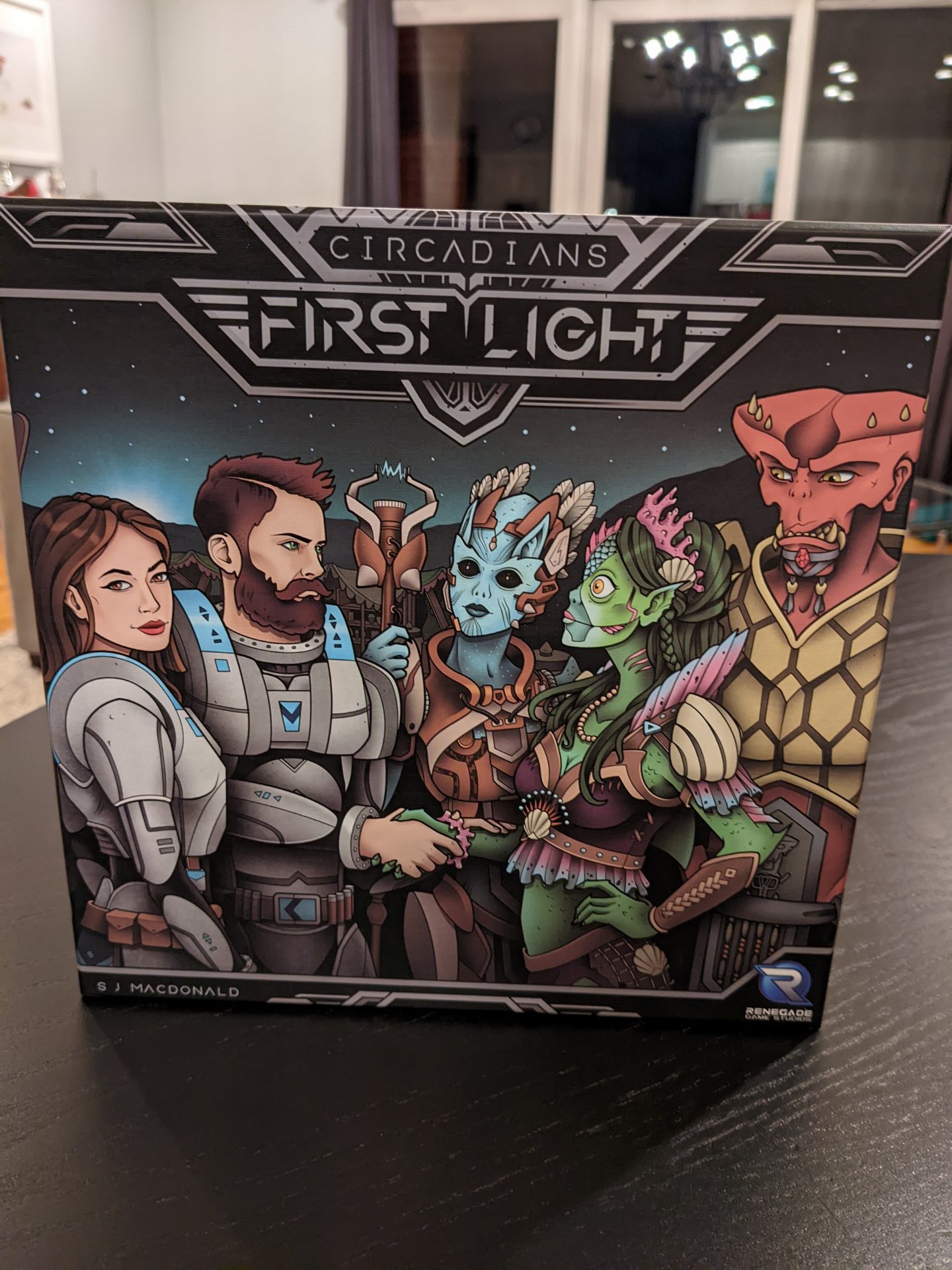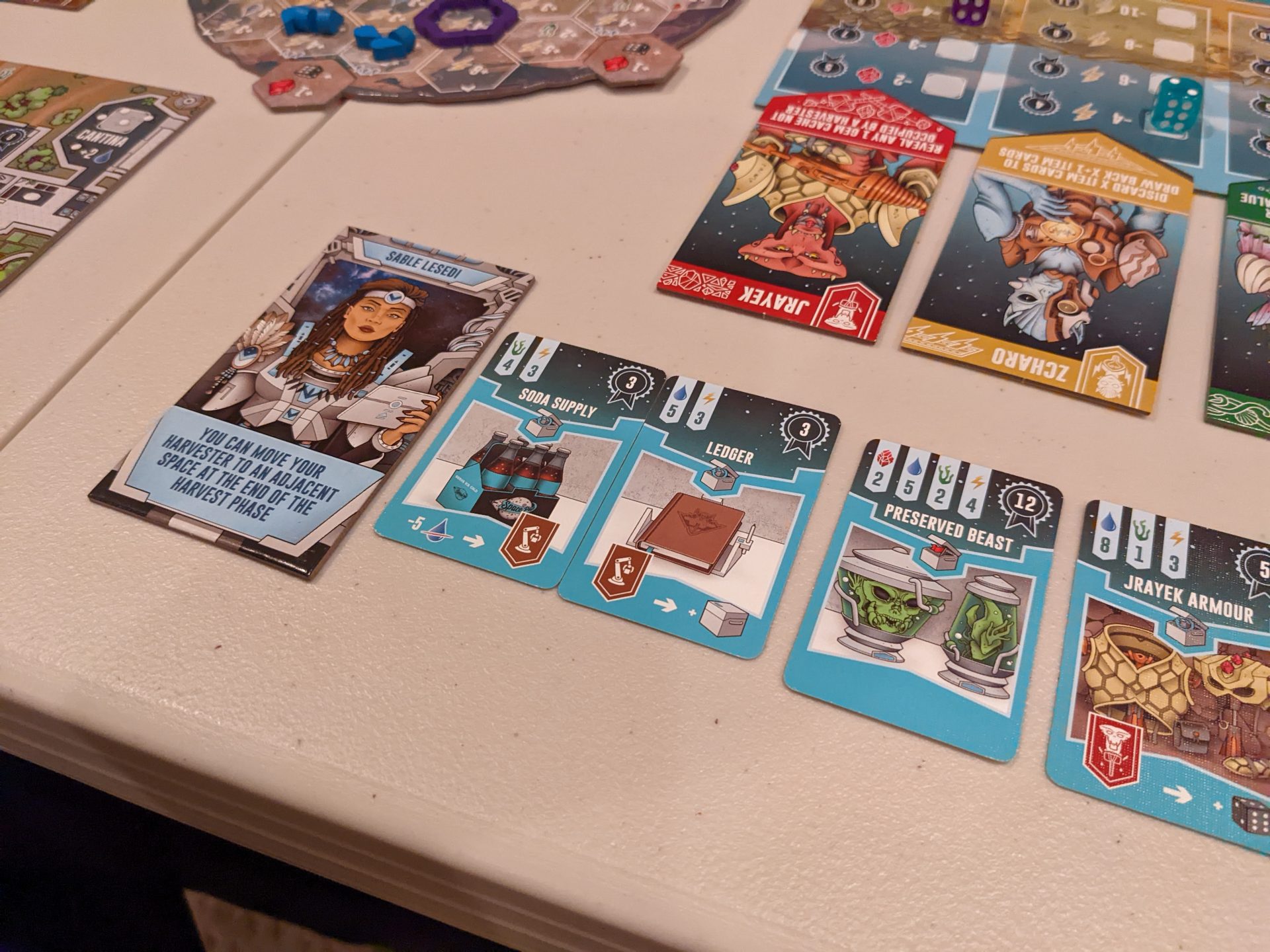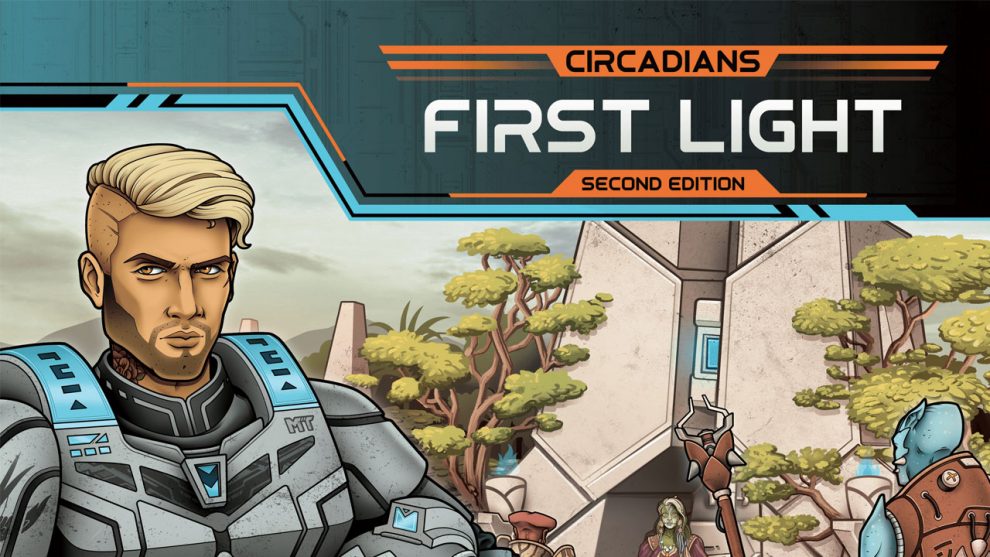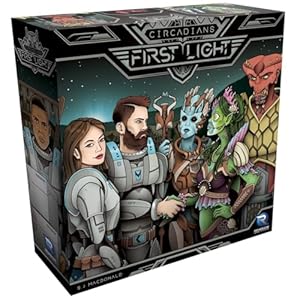The box is small, but mighty. The game looks like it won’t feature a lot of interaction, until you’re fighting with another player for the one spot where you can get the most valuable resource. The art is a turnoff, but the iconography is really smooth. And even though the game plays well at 3 or 4 players, the solo experience might be the best way to play.
I’m talking about Circadians: First Light, which was designed by Sam Macdonald (Architects of the West Kingdom and Raiders of Scythia), developed by Shem Phillips (those same games, plus Raiders of the North Sea), and published by Renegade Game Studios. Circadians: First Light is a fun experience that surprised me. I didn’t really enjoy Architects of the West Kingdom or similar games, which often beckon me to level the term “multiplayer solitaire” on those experiences. When I saw that Circadians: First Light was designed by the same team, I was a little nervous about dropping cash on this game.
But Circadians: First Light has dice. LOTS of dice. And since there is no such thing as too many dice, Circadians: First Light makes me quite happy and offers a pleasant gaming experience.

Oh, NOW I See the Interaction
It was all fun and games until you raised your player screen to keep my prying eyes from watching you program your dice to devise your action plan!
Let’s back up a moment.
In Circadians: First Light, players are researchers working with their crew members to recruit new workers, mine a distant planet for gems while also harvesting and collecting resources to build structures and items, and negotiate with locals to establish trade and gain rewards. Over 8 rounds, whoever has built the best engine will win.
Yes, there’s a little more to the backstory, but ultimately, you are here to build an engine. Euro gamers will feel right at home going from round to round and it is immensely satisfying to spend the first few rounds building up your research team. This is especially true as players lean into their starting player powers, which break the rules of a single aspect of normal gameplay.
Rounds are breezy, especially at lower player counts. After a new event card is revealed, players roll their dice—workers—behind their screen and then get to work. (Event cards in this game only affect rules slightly; on a scale of 1 to Dominant Species, this game’s event deck is a 2 in terms of impact.)
The beauty of planning in Circadians: First Light is that spaces used to complete tasks are limited, in terms of quantity, but also limited in terms of which pip faces on the standard 6-sided dice here can actually “work” in locations. For example, depending on the number of players, there may be only 2 spaces at the Mining Camp, a great place to get gems on the cheap. But what if you are playing second in a round, and there’s only one space you can use because your water supply is limited?

In another case, the Laboratory only accepts two dice of equal value. And there’s only one player who can go there in a round. What if your hopes and dreams are tied to that one location, and another player goes there first?
Once the planning phase is over, you find out if those dreams will be dashed during the Execute phase. Players take turns placing one die (or 2 at the Laboratory) to take an action. If you can take all of your actions, great, but it’s always going to be a race. If you can’t use all of your dice IN ORDER from left to right on your player board, all remaining dice are lost and you’ll get a very sad amount of water as compensation for a future round.
Your options for actions are many. You might trade at the Market, where you can swap water for algae or power for gems. You might move your Moon Patrol-style “Harvester” to a new space on the planet board, where you can generate resource income near the end of the round to play into your strategy. You could recruit a couple of extra workers (dice) at the Academy to use in future rounds.
Or, you can retire a die to negotiate with the creatures who inhabit the planet, by paying the locals resources (water, algae, power) to lock in a one-time benefit and a one-time free action from the creature you’ve just satisfied. This board, the Negotiations track, represents a big chunk of points you will earn by saving up your resources.
You can also retire dice on the Depository board, where you can block a space to play an item card from your hand. These cards grant ongoing benefits or end-game scoring opportunities, along with victory points listed on the top of each card.
During the Execute phase, turns are quick and rounds only take a few minutes. After players conduct the Harvest phase to collect their resource income, everyone takes their dice back (at least, the ones not retired on one of the boards listed above) and they do it all again for 8 rounds.

Let’s Talk About the Art
So, I get that lots of people have commentary on the art in Circadians: First Light. I’ll admit that I heard about the art of the game before I heard about the gameplay. That is unique!
The artwork in Circadians: First Light is fine. It’s not weird, it doesn’t feel out of place (although I wish that the only person looking out from the box cover at me was NOT the attractive human female “negotiating” with alien species), and it doesn’t set a strange tone while playing the actual game.
I like the skills diversity of the 8 player tiles, and that the alien powers for the Negotiation board have gendered sides. (No, I don’t know why all sci-fi art seems to feature human-like beings with red skin or purple horns. But those aliens always seem to have hands you can shake, so I’ll take it.)
The artwork IS unique. I don’t think it is necessarily my thing, my style, my preference, my jam, but it’s not nearly as problematic as I was expecting given the commentary I saw online. I don’t think the artwork in Circadians: First Light is good, but it’s not bad either.

The Insert: Top Five Ever
I went through my game collection in preparation for this article. I am certain I can say this: Circadians: First Light packs more game into a small box with a fabulous insert than any other game ever. (I’ll try to find more chances at hyperbole later.)
The insert is perfect. Everything inside fits just right: the water resources, the player tiles, all of those dice, the Harvester pieces, all the boards. Unpacking the game is a cinch. Tear down and storage is also cake. It also feels good—weirdly good—to put the game back on the shelf because you can stand it on its side and everything doesn’t tumble out of position.
It really is the perfect game box. But while the insert is perfect, it is worth noting that this perfection comes at a cost: everything in the box is a little smaller than it needs to be.
The dice are tiny. (Think Sagrada in terms of size.) The resources are almost comically tiny. The water tokens are so small that, just like real water, these tokens will run through your fingers as you try to scoop them up to pay for things in the game. The player screens are small. The item cards are small. The text on nearly everything is small.
Now, Circadians: First Light isn’t tiny, as in a replica of the Tiny Epic series from Gamelyn, where everything is small enough to fit into your purse. Circadians: First Light just does a lot with a small footprint; it’s almost as if Renegade planned for game owners to play this on a small kitchen table. There’s some beauty in that this game will fit on almost any respectable table you throw at it. But for those of us who like their productions big and chunky, Circadians: First Light is a miss.

The AI
Circadians: First Light accommodates 1-4 players, but in my plays I have found that playing solo or with 2 players is the best way to go. That’s because turn planning can be quite slow when players are trying to determine how to best utilize 2-5 dice in a round, a couple of which are going to be buried on the Negotiations or Deployments board during that round. The game scales quite nicely with double-sided location boards, so that spaces are the right fit for the player count.
Circadians: First Light has solo gamers covered and now that I’ve played it 6 times solo (mainly to try out the majority of the variable player powers), that’s the way I’ll be playing it in the future.
There are 4 levels of AI/automa to play against, and while it is fairly easy to beat the “Easy” setting, the other 3 levels will give you a run. As a teaching tool, the solo in Circadians: First Light is also a perfect way to learn the game, and taking AI turns with its dedicated deck is quick and simple. The way the AI scores doesn’t feel like a cheat; in fact, in my first human multiplayer game, an event card which allowed players to spend item cards as 2 algae each suddenly meant that everyone was able to retire a die with the alien who desires algae on the Negotiations board on the first turn of the game.
And playing against the AI addresses the main issue with Circadians: First Light: AP (or analysis paralysis).
Analysis paralysis is really something here, but when playing solo you can take your time thinking through the best way to complete your actions that max out your dice. Running through the automa cards still means that you may get hosed a few times, so you’ll have to pivot and use different actions. The solo fits as a teaching tool and it simulates what other people will do when they reveal their dice selections.
Solo games of Circadians: First Light usually take 30-40 minutes, and between the thinking time and the setup/teardown, it usually takes just under an hour to go through the motions. As a puzzle, that’s a satisfying amount of time spent on the game.

The Future
Circadians: First Light already has a second edition as a fully-funded Kickstarter campaign delivering in late 2022. From the looks of it, the artwork is being addressed mainly to line up with the newest game in the line, Circadians: Chaos Order, but I’m guessing to also address some of the commentary about the artwork and iconography I’ve seen online.
The thing I’m most intrigued about? Circadians: Chaos Order is, per the Kickstarter campaign, a “competitive, confrontational area control game with highly asymmetric factions.” In other words, this represents a very different game from Circadians: First Light. Also, this first game has 52 dice included, while Circadians: Chaos Order has just two. It’s a much more deterministic approach, so color me intrigued!
As a first edition owner, I’m really happy with Circadians: First Light and I’m looking forward to keeping this one in my collection for the time being. It’s an easy game to teach, it plays well solo and with 2 players, and the variety of player powers and event cards along with different dice rolls means I’m getting something a little different every time I play.












Add Comment